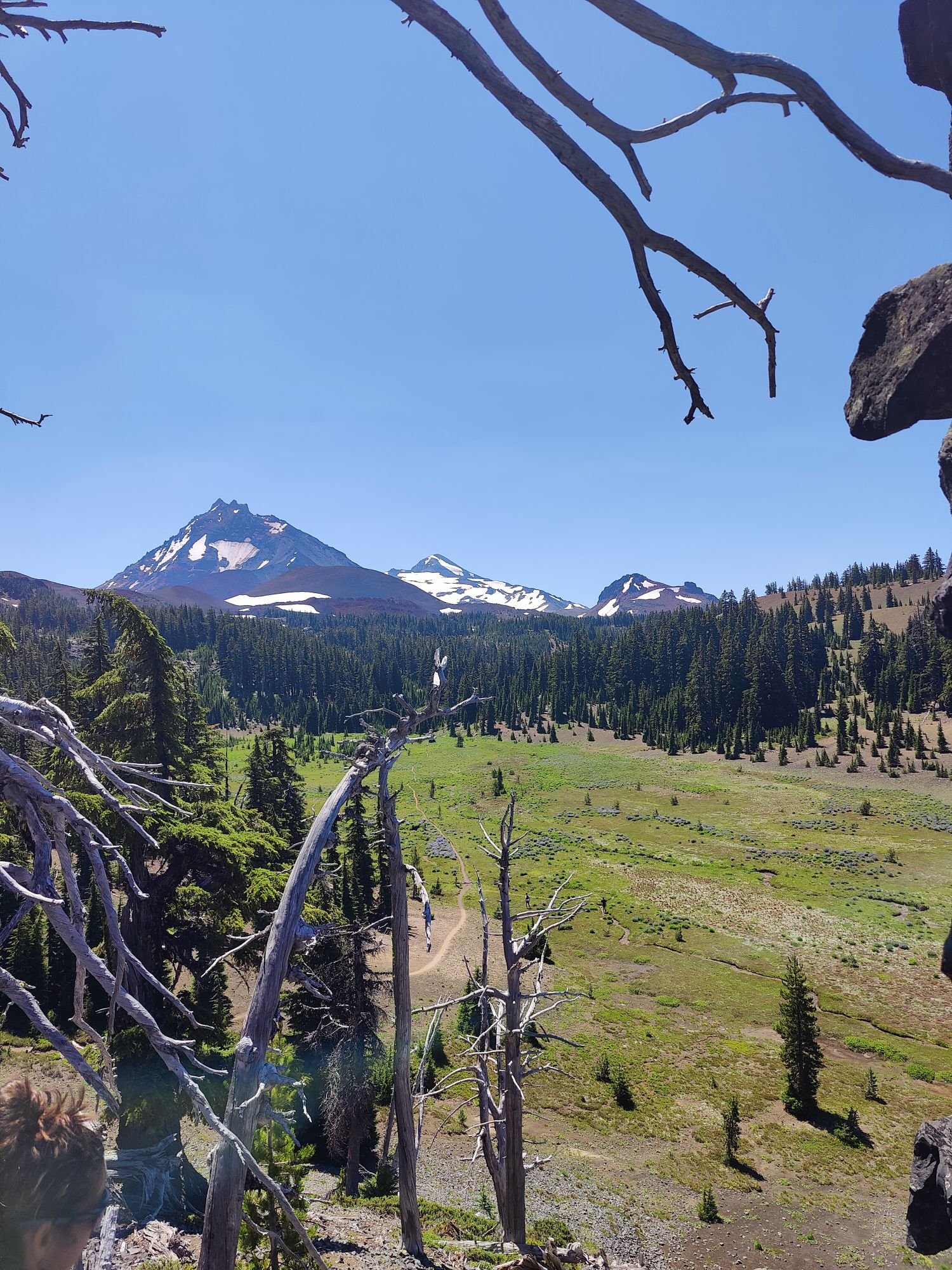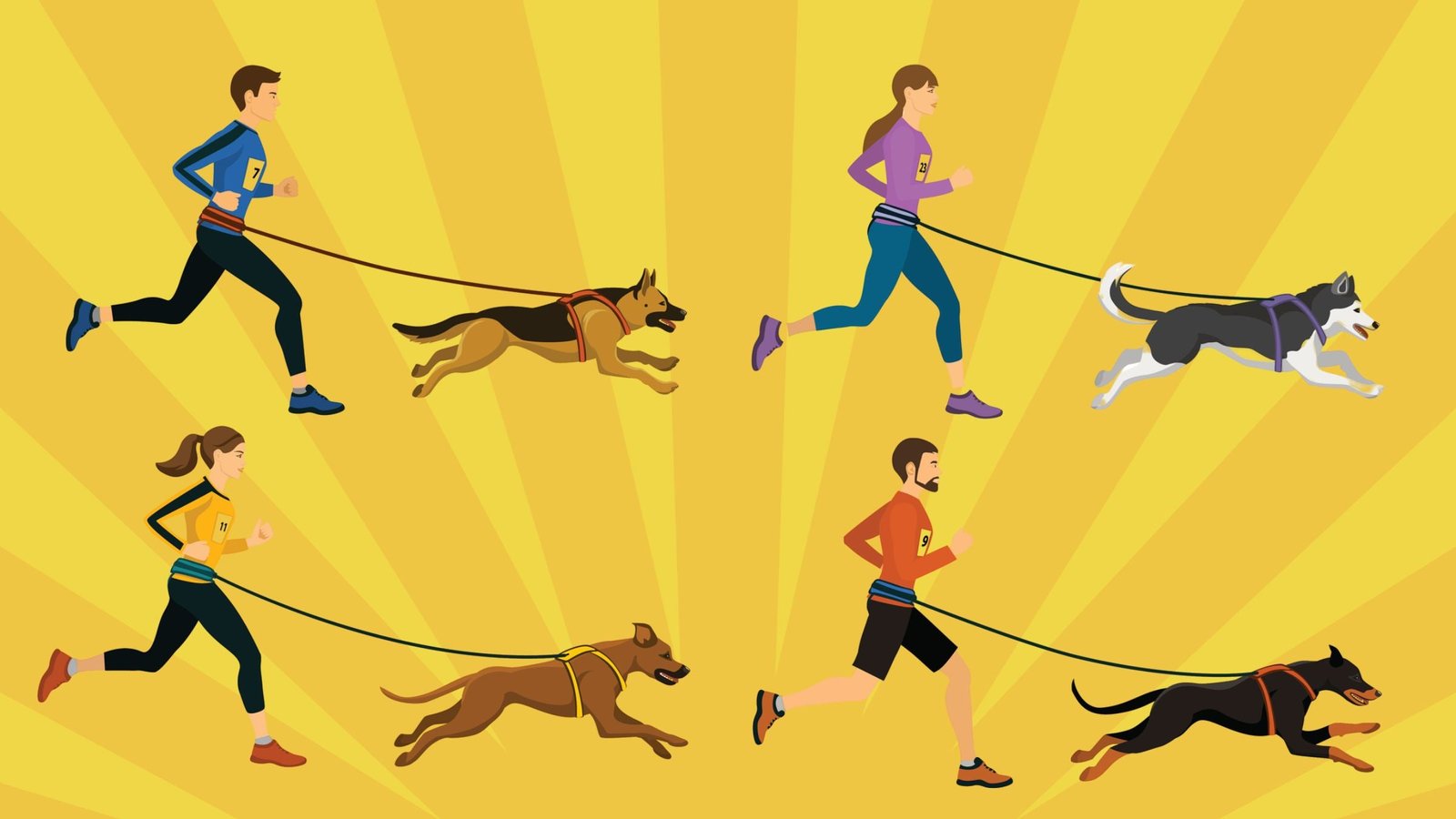Published August 9, 2025 03:08AM
Destinations & Things To Do
Maiden Peak Shelter: Am I an intruder?

Back on trail, the adventure has begun
After staying in Bend with my friends from 2019, getting the last preparations done, it was time to finally hit the trail again. They dropped me off at Shelter Cove and I wondered how I would feel coming back. There was no big excitement on the drive from Bend to the resort and this made me worry. However, as soon as I was there, things changed.
I could immediately spot other hikers, some in their rain gear which means clothes were in the laundry, others just hanging around. It is fascinating how the eye can spot long distance/thru hikers after spending some time on a long distance trail. All of us wear some sort of uniform that distinct us from others.
At first a little shy because I was all fresh and haven’t hiked at all this year I approached the other hikers in the PCT tent of Shelter Cove. We immediately had nice chats about our trail experiences. It felt good to talk and after an ice cream it was time to head out. When saying good bye to the hikers at Shelter Cove the words “See you out there” and “Happy Trails” struck me.
These were the words that we told each other all the time in 2019 and they triggered a feeling that I have missed for so long. They meant being back on trail and being part of a community of hikers that are out there to not only walk to Canada but to have the best time possible each day.
The first night on trail
It felt like Maiden Peak Shelter would be a good first stop on the trail and I was the first one there. Making sure the door was properly closed to prevent mosquitos from flying in, it was time to make some dinner. Dinner was freeze dried refried beans from back home mixed with some ramen. I hoped to find some more of those beans but things have not changed in the 6 years I was off trail. Freeze dried refried beans are still as rare as a gem.
After a while other hikers came in and we talked about how terrible the mosquitos are and how they are trying to run up to Canada as fast as possible. This is because they are afraid to have to skip sections of the trail due to wildfires. We all went to sleep and the next morning all of them got up around 5am to make big miles. They were chatting about me still being asleep and not up yet. Doing so they gave me an uncomfortable feeling.
Why should I get up this early? I have no trail legs to cover big miles yet, therefore there is no need to get up so soon. After they have left, I was sitting in the shelter, realizing that I am not in the spheres as I used to be. It was a weird mix of desperation to have trail legs back and also wonder about why these guys apparently were judging. Anyway, it was time to head out and hike.
First days back on trail
The first days of hiking were a mix of running away from mosquitos and taking long breaks on the shore of lakes. Surprisingly few mosquitos found their way to the shores of the lakes which made them really comfortable places to rest. Since it was not possible to walk so many miles, I perceived the landscape around me in a much different way compared to 2019. For example, every lake I passed, I jumped in to swim. While I have been only swimming in 2 lakes in 2019 it was already 6 in the first days this year. That was amazing!
Hiking itself felt easy and getting used to live in a tent was no problem at all. The conversations with other hikers were mostly me talking about my story and almost apologizing that I did not start at the Mexican border. Even though the hikers did not care about me not having started at the border, I still felt I did not belong to them.
Three Sisters Wilderness
After being chased by countless mosquitos in a green tunnel, only interrupted by burnt areas, suddenly some vistas opened up. The Three Sisters Wilderness was the first of many small milestones that I could reach and it was breathtaking. Since leaving the trail in 2019 I dreamt about this part of the trail and walking over the lava fields. Finally I was there. Joy and excitement mixed and provided energy for some hotter days. It was also necessary for the mosquitos because they have changed. Less in numbers but much more aggressive than in the woods they tested my patience a lot. Many meadows in the area invited for breaks and there were some nice talks with day hikers. Long distance hikers were in much lesser numbers and I wondered where they were.
But more about this in the following post.
This website contains affiliate links, which means The Trek may receive a percentage of any product or service you purchase using the links in the articles or advertisements. The buyer pays the same price as they would otherwise, and your purchase helps to support The Trek’s ongoing goal to serve you quality backpacking advice and information. Thanks for your support!
To learn more, please visit the About This Site page.
Destinations & Things To Do
How Canicross Saved My Relationship with My Unruly Rescue Dog

I couldn’t fix my dog’s behavior until we started running toward a shared goal—literally
(Photo: Vect0r0vich/Getty, Abigail Wise)
During the first year of living with Halle—a German shepherd-bordie collie mix adopted at ten months old—I felt like a prisoner to my pet.
When guests came over, she believed it was her duty to drive out the invaders from our house, barking nonstop until they walked out the door. If we left her alone at home, she would panic, pace, and become destructive—I once swiftly returned after seeing her attempting to chew through her wire crate in the doggy viewing camera I’d installed. Outside, Halle screamed and threw her body against the leash when she saw another dog, overcome with strong emotions. She obsessed over rabbits and squirrels, blowing me off to pursue them; she once killed a baby bunny while leashed, snapping it up and shaking it to death before I could say “leave it.”
On the advice of trainers, I shrank our lives. I walked her early in the morning on steep, loose trails that no one else wanted to hike. Friends no longer came over to the house. If we saw a dog while we were out, I would sometimes hide with Halle behind a bush or car. In my quest to calm her down, most of my non-essential income went to trainers. One, after ten lessons with no result, suggested that perhaps some day Halle might simply “grow out of it.”
Today, more than two years after adopting Halle, we are in a better groove. Our communication is clearer, and many of her worst impulses have been tamed. I credit our success to better training advice and discovering canicross.
For those unfamiliar, canicross is the sport of trail running with your dog attached to you—and, ideally, pulling ahead. The dog wears a special harness that allows unfettered movement, which is clipped to a bungee line attached to the human’s running waist belt. Originally an off-season activity for sled dogs, handlers use similar commands to mushers, instructing their dogs to “hike” and “gee” and “haw”—AKA hurry up, go right, and go left. In recent years, the sport has taken on a life of its own, with national organizations, local groups, and races.
For Halle and me, it started as a bit of an accident. Tired of being dragged by her on our pre-dawn hikes, I made a knot in her 15-foot leash, clipped it around my waist, and ran a three-mile loop on the trails (note that I do not recommend this sketchy setup). For once, her frantic behavior was not a problem—instead, her pulling made my uphills a little easier.
Later that day, I took her on a walk through a busy park on the same long leash. She didn’t bark or lunge at the dogs; she seemed more interested in exploring and sniffing. Maybe the run removed some of her pent-up frustration.
So much of what we ask of pet dogs is in conflict with their instincts and desires. For instance: walking by our sides. Many dogs naturally walk faster than us—meeting our pace probably feels like getting stuck behind a slow driver in the left lane. Dogs want to explore, sniff, and run in their limited time outside, and walks on a short leash can’t satisfy those needs.
Of course, dogs still have to fit into our world—learning to walk nicely on a leash, come when called, potty outside, and otherwise behave are essential to living harmoniously with humans. But when dogs don’t have outlets for their natural behaviors, owners sometimes find themselves playing dog training whack-a-mole, engaged in a never-ending battle to stop problematic barking, pulling, jumping, and digging.
That’s why having a mutually enjoyable activity is so important. A shared sport bolsters the canine-human relationship, which in turn makes it easier to do necessary-but-less-fun training.
By allowing Halle to run full-steam ahead, we finally had a shared purpose: shredding the trails. I found an online class on pulling sports and ordered proper equipment. Halle learned commands for walking to the end of the leash, speeding up, slowing down, left turns, and right turns.
I taught her that sudden sniff stops were a no-no, as was dragging me down loose slopes, but those rules came relatively easily just like how we humans accept rules in sports and board games.
Outside of canicross, we also focused on life skills, teaching a reliable “come” and “heel,” and practicing around dogs, squirrels, and other distractions. We used play to build impulse control, too, progressively strengthening her “drop it,” “wait,” and other commands around toys she was eager to chase.
Last fall, I met with another Reno canicross runner and her dog, and saw how all the running and training had paid off. I was nervous ahead of the run with Halle’s history of unruly and explosive behavior around dogs.
We started the run behind the other team. Halle was amped to see another dog, but she channelled her energy into pulling me up a switchback. Within 20 minutes, we were jogging and hiking close enough to have a conversation. Halle looked unsure around the new dog, but also glanced backward with worry when we lost sight of them after turning a corner—she seemed to realize we were a group and wanted to stick together. She made more progress over a one-hour run than she had over multiple training sessions with a trainer’s dog. She and Chase, the husky-pitbull mix, are now good friends.
In April, we entered our first race together in Susanville, California. Halle hunched nervously between the runners as we were crammed together at the start line. But once we started running, she was on fire. I flew the first two miles as she threw her weight into the harness—race volunteers joked that I was cheating (it was a dog-friendly race, but not explicitly canicross). She galloped past distractions she’d never encountered before, including photographers and volunteers ringing bells. After missing an unlabelled turn, we ended up running an extra mile and a half, but she was a better sport about it than me. She got her second wind after seeing a squirrel at mile five, giving me a much-needed boost.
After the race, we basked in our accomplishment. We might have botched the actual course, but we had cleared a hurdle in a larger race. In a new place amid crowds, our teamwork had shone through, and we ran together without a hitch.
Now, I’m organizing group runs in my area to build more interest in the sport. Maybe other people struggling with their pups can realize the potential and teamwork that canicross brings about.
Destinations & Things To Do
HGTV said you must visit Chutters candy counter, Wild Blueberry Land

Deer crashes into popular brunch spot
The Friendly Toast, a popular brunch spot in New Hampshire, delayed opening after a deer crashed through their window.
Summer’s almost over, why not end it with a classic family road trip?
And these two stops might be the road trip destinations you’re looking for.
HGTV ranked the top 50 must-see roadside attractions in the United States, with one for each state, and the Home and Garden Network named two locations as New Hampshire’s and Maine’s best roadside attractions.
“Most of these stops are located right off major highways for easy hop-out and hop-back in photos,” HGTV said. “But there are a couple of gems worth the county road detour that we couldn’t resist including.”
Here’s what HGTV picked as the best and most eye-catching roadside attractions in New Hampshire and Maine.
Chutters, Littleton
HGTV chose Chutters as New Hampshire’s most stunning roadside attraction because of its record-breaking confectionary feat as well as its historic longevity.
What HGTV said about it: “No road trip would be complete without snacks, and if you’re driving through New Hampshire, you have to stop at Chutters—especially if you have a sweet tooth. Home of the world’s longest candy counter, this sugary shop in Littleton, New Hampshire, has been on Main Street for more than 100 years, and it features 112 feet of glass containers with all kinds of rare, nostalgic confections. And while the candy is most famous, don’t miss Chutters’ homemade fudge and chocolate, too.”
You can find Chutters at 43 Main St. in Littleton, New Hampshire. It operates from 10 a.m. to 5 p.m.
“Grab a bag and choose from the vast array of sours and gummies, gourmet and traditional jellybeans, chocolates, licorice, caramels, and nostalgic pieces,” the Chutters website said. “Chutters is a treasure trove of tasty treats!”
Wild Blueberry Heritage Center, Columbia Falls
HGTV chose the Wild Blueberry Heritage Center because of how it highlights one of Maine’s most prized culinary achievements: cultivating the wild blueberry.
What HGTV said about it: “If you didn’t make a pitstop for a lobster roll, you didn’t road trip through Maine. However, The Pine Tree State also boasts another hallmark eat: wild blueberries. And the Wild Blueberry Heritage Center (formerly Wild Blueberry Land) on Route 1 in Columbia Falls is the place to get your fix. Handbuilt by wild blueberry farmers Marie and Dell Emerson in 2001, the bakery-meets-museum is literally shaped like a blueberry, with additional quirky structures to pose with. There’s a blueberry pie canopy, a blueberry throne, and inside you’ll find tasty treats, from fresh-baked pies to wild blueberry coffee.”
You can find the Wild Blueberry Heritage Center at 1067 U.S. Route 1 in Columbia Falls, Maine.
The heritage center operates from 10 a.m. to 5 p.m., opens its doors starting June 27, and closes its doors on Oct 13, the Wild Blueberry Heritage Center website said.
Rin Velasco is a trending reporter. She can be reached at rvelasco@gannett.com.
Destinations & Things To Do
Bangkok continues to strengthen its reputation as a top tourist destination

The campaign targets key markets including India, China, Malaysia, Laos, and Vietnam, offering special deals on accommodation, travel packages, and shopping, alongside promoting emerging tourism trends such as wellness travel, music festivals, sports, and international events.
“The government reaffirms Thailand’s readiness as a world-class destination, offering safety, service excellence, and unique charm, while continuing to strengthen the tourism sector for sustainable growth,” Sasikarn said.
-

 Brand Stories3 weeks ago
Brand Stories3 weeks agoBloom Hotels: A Modern Vision of Hospitality Redefining Travel
-

 Brand Stories2 weeks ago
Brand Stories2 weeks agoCheQin.ai sets a new standard for hotel booking with its AI capabilities: empowering travellers to bargain, choose the best, and book with clarity.
-

 Destinations & Things To Do3 weeks ago
Destinations & Things To Do3 weeks agoUntouched Destinations: Stunning Hidden Gems You Must Visit
-

 Destinations & Things To Do2 weeks ago
Destinations & Things To Do2 weeks agoThis Hidden Beach in India Glows at Night-But Only in One Secret Season
-

 AI in Travel3 weeks ago
AI in Travel3 weeks agoAI Travel Revolution: Must-Have Guide to the Best Experience
-

 Brand Stories1 month ago
Brand Stories1 month agoVoice AI Startup ElevenLabs Plans to Add Hubs Around the World
-

 Brand Stories4 weeks ago
Brand Stories4 weeks agoHow Elon Musk’s rogue Grok chatbot became a cautionary AI tale
-

 Brand Stories2 weeks ago
Brand Stories2 weeks agoContactless Hospitality: Why Remote Management Technology Is Key to Seamless Guest Experiences
-

 Asia Travel Pulse1 month ago
Asia Travel Pulse1 month agoLooking For Adventure In Asia? Here Are 7 Epic Destinations You Need To Experience At Least Once – Zee News
-

 AI in Travel1 month ago
AI in Travel1 month ago‘Will AI take my job?’ A trip to a Beijing fortune-telling bar to see what lies ahead | China

You must be logged in to post a comment Login